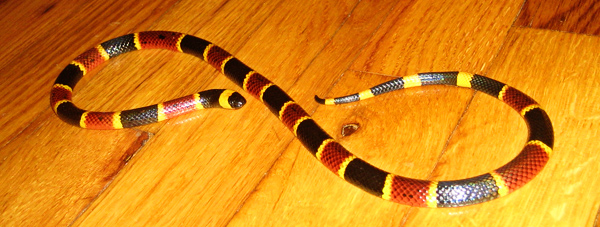- info@wildlifeanimalcontrol.com
Call us for help in your town
Wildlife Control Education
The Coral Snake
The Coral snake belongs to a large group of snakes referred to as “Elapid”, it is also referred to as the Coral adder, Florida coral snake, American cobra and Eastern coral snake. There are over 65 distinctive species of this snake known. This snake is referred to scientifically as “Micrurus fulvius” and it is predominantly found in South Eastern part of the United States.

Appearance
Coral snake is generally less than 80cm in length, while the maximum reported length was about 122cm. Males possess longer tails than females, but females eventually reach greater lengths. The dorsal region of the snake has 15 rows of smooth scales, while the ventral scales are rougher. The color of the snake has series of rings, encircling the entire body length. The wider red and black rings of the length of the body are separated by yellow rings.
Learn more: Can snakes climb stairs or a wall?
Biology
Fatalities associated with Coral snakes are quite rear, even though they are venomous in nature. Coral snakes do not account for more than 100 bites a year, but the snake can release its venom even with a single bite.
life cycle
A typical female can lay between 3-12 eggs especially between the months of June and August and the eggs are hatched between September and October. The young neonates are usually less than 23cm in length. The snake can reach maturity within few months and its life cycle is usually between 6 months and 2 years.
Learn more: The Water Moccasin Snake
Habitat
Coral snake is predominantly found in South-eastern part of the United States , and can also be found at sea level altitudes ( up to 400 meters). The snake prefers tropical hammocks, high pine, and glade land areas. It can also be found in Flatwoods, scrub oaks, and Glade lands. The snake prefers dry and open ground areas that have some sparse vegetables and bushes. It can also be found on some sandy ridges in places such as Mississippi, and the sandy creeks in Louisiana. Scrub oak forests and Pine habitats are the best places to find Coral snake.
Diet
Coral snake eats predominantly reptiles and smaller snakes. It prefers smaller frogs , and lizards. It also feeds on small insects and some small sea creatures.
Behavior
Coral snake moves quickly especially through sandy terrains, it is one of the fastest snakes around and a dry bite from the snake can be a deflection or near miss of its victim. Despite being found in sparse vegetation, the coral snake can hide perfectly in the sand, or among shrubs. It is capable of climbing trees and crawling through water. The snake prefers warmer climates and it normally forages when the weather is hot , thus it can be easily found in the day and less in the night.
Go back to the How to get rid of snakes home page.
Need snake removal in your hometown? We service over 500 USA locations! Click here to hire us in your town and check prices - updated for year 2020.

















